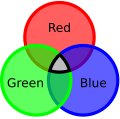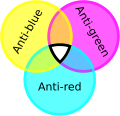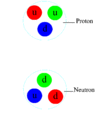Strong interaction facts for kids
The strong interaction, also known as the strong nuclear force, is one of the four basic forces in physics. These forces are called fundamental because scientists can't explain them in a simpler way.
The strong force is super important because it holds most of the ordinary matter around us together. It works in two main ways. First, it holds tiny subatomic particles like neutrons and protons together. Second, it keeps the entire atomic nucleus (the center of an atom) from falling apart.
This force is the strongest of all fundamental forces. It's an amazing 1038 times stronger than gravity! But here's the catch: it only works over extremely short distances, just a few femtometres (fm). A femtometre is incredibly tiny, like 0.00000 00000 00001 metres.
Scientists often think about the strong interaction as two separate forces: the colour force and the nuclear force.
- The colour force acts over very short distances (0.8 fm or less). It holds the even tinier particles called quarks together inside subatomic particles like protons and neutrons.
- The nuclear force is like the leftover strong force. It works over slightly longer distances (1 to 3 fm) and is what keeps protons and neutrons glued together inside the atomic nucleus.
The strong interaction happens because of special particles called gluons. Think of gluons as the "glue" that holds quarks together. Quarks, antiquarks, and gluons themselves can swap these gluons. These particles have something called a colour charge, which is a bit like electric charge. Particles with colour charge exchange gluons, similar to how particles with electric charge exchange photons.
The scientific theory that explains the strong force is called quantum chromodynamics (QCD). This theory describes how the strong force acts between quarks and gluons. It's the basic force controlled by gluons, affecting quarks, antiquarks, and the gluons themselves.
The strong force affects quarks directly through the colour force. But when it acts between hadrons (like protons and neutrons, which are made of quarks), it's known as the nuclear force. This nuclear force isn't considered a fundamental force itself, but a result of the underlying strong force.
Because the strong force is so powerful, we can't find "free" quarks (quarks by themselves). Scientists believe that if you tried to pull a quark away, it would take so much energy that new hadrons would simply be created instead. This idea is called colour confinement, and we see it happen in particle accelerators.
What is the Colour Strong Force?
The colour strong force is the strong interaction that holds the three quarks inside a proton or neutron together. It's called the "colour" force because, like the electromagnetic force, the strong force has different types of "charge."
The electromagnetic force has only one type of charge (positive or negative). But the strong force has three types of "colour" charges: red, blue, and green. They also have "anti-colours": anti-red, anti-blue, and anti-green. Just like positive and negative electric charges attract, different colours attract, and the same colours repel.
Particles that have colour charge include quarks and antiquarks. The "flavour" or type of quark (like up, down, strange) has nothing to do with its colour charge. Quarks are among the smallest particles we know. They are thought to be point-like, meaning they take up no space. We haven't been able to break them apart from other particles yet. This is because the strong force gets stronger the further apart the particles are.
The particle that carries the strong force is called the gluon. Gluons also have colour charge. Both quarks and gluons have special properties that make them unique, as described in the Standard Model.
What is the Nuclear Force?
The nuclear force, also known as the residual strong force, is the leftover strong force that acts between hadrons. Hadrons are particles made of quarks, like protons and neutrons. This is the force that holds the nucleus (the center) of an atom together. It's what stops the positively charged protons in the nucleus from pushing each other apart.
Related topics
See also
 In Spanish: Interacción nuclear fuerte para niños
In Spanish: Interacción nuclear fuerte para niños




